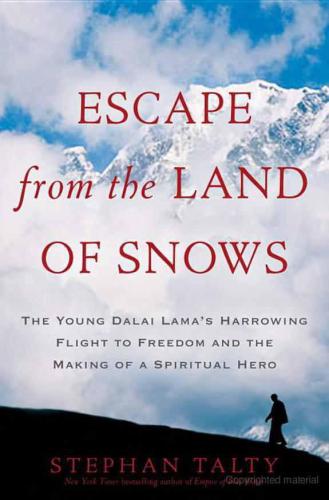
Escape from the Land of Snows
The Young Dalai Lama's Harrowing Flight to Freedom and the Making of a Spiritual Hero
کتاب های مرتبط
- اطلاعات
- نقد و بررسی
- دیدگاه کاربران
نقد و بررسی

November 8, 2010
Drawing from written eyewitness accounts and interviews with survivors, Talty (The Illustrious Dead) describes the events in 1959 that irrevocably altered the future of Tibet. He skillfully moves between protests in Lhasa and the Dalai Lama's escape toward the border, tracing stories of the many people involved. Adding complexity to this narrative are details about CIA support of Tibetans fighting against the Chinese regime, the U.S. role in securing permission for the Dalai Lama's entry into India, and the worldwide media frenzy that shaped the public's perceptions of Tibet. Witness reports include those of the Dalai Lama's mother and brothers, rebels and refugees, members of the CIA's Tibetan Task Force, and former prisoners of the Chinese. From these multiple voices the author has woven a vivid picture of a dangerous journey and a country in crisis. The accompanying analysis provides context for the intricate events that changed the young leader into a "movable Tibet," and an isolated mountain society into an international cause and "a place of the mind."

October 1, 2010
A riveting, informed narrative about the current Dalai Lama's 14-day escape from Chinese-occupied Tibet in 1959.
Journalist Talty (The Illustrious Dead: The Terrifying Story of How Typhus Killed Napoleon's Greatest Army, 2009, etc.) uses this remarkable historical event to tell the greater story of Tibet's transformation from a veiled kingdom to a world cause, and the Dalai Lama's coming of age from a teenage king and living god to an international spiritual leader. The author effectively gives the reader an introductory lesson in Tibetan history and a sense of the Tibetan people while maintaining the pace of an adventure tale. The Dalai Lama is always at the center of the story, even in passages told from other points of view, including Tibetan Khampa soldiers and CIA agents. After being discovered as the next Dalai Lama at age two, then struggling with the loneliness and formality of palace life, he ascended the throne early, at 15, upon Mao's invasion. The Tibetan people endured Chinese occupation and escalating brutality for nine more years before a true rebellion emerged in response to a rumor that the Dalai Lama's life was threatened. As his peace-loving people tried to hold off the ensuing Chinese attacks on the palace, the Dalai Lama was forced to flee with plans to establish a provisional government outside the capital. But after days of sandstorms, blinding sun, avalanche blizzards, dysentery and threats of leopard attacks in the 19,000-foot passes of the Himalayas, the Dalai Lama and his group learned that the Chinese were on their trail. The chase was followed by President Eisenhower, protesters worldwide and a colorful cadre of journalists who introduced Tibet to the world, "becoming famous just as it ceased to exist." The Dalai Lama was granted asylum in India, where the he still resides, mournful for Tibet but now able to spread his culture's peace and compassion in ways previously unimaginable.
A great read for Tibetophiles old and new.
(COPYRIGHT (2010) KIRKUS REVIEWS/NIELSEN BUSINESS MEDIA, INC. ALL RIGHTS RESERVED.)

September 15, 2010
In an introduction, 16 chapters, and an epilog, journalist Talty (Empire of Blue Water) covers a great deal of ground: a history of Tibet and its relations with China; how Tibet came to be governed by religious leaders (the 14 Dalai Lamas); the character and experience of the current Dalai Lama; and why China under Chairman Mao decided to fully take over the governance of Tibet (a "province" that China believed it controlled), thus causing the Tibetans (who long believed themselves independent) to rise against Chinese occupation. It's a history of mutual mystification that culminates in the slaughter of one-fifth of the Tibetan population and the exile of thousands more, including the Dalai Lama. Talty writes very well, and much of the book is moving (especially when he writes about the suffering of the Tibetans and the ruthlessness of China's People's Liberation Army). He shows how everyone involved (China, the UK, India, the United States) misunderstood the Tibetans and how the Tibetans misunderstood the direness of their situation. VERDICT Well worth reading, especially for those interested in 20th-century political and religious history or Asian history and society. Recommended.--James F. DeRoche, Alexandria, VA
Copyright 2010 Library Journal, LLC Used with permission.

Starred review from January 1, 2011
In spite of the Dalai Lamas great renown, the complete story of the brutal events that forced him into exile is not widely known. Talty takes readers back to 1950, when the Dalai Lama was a 15-year-old sheltered monk in Lhasa as China invaded with 80,000 seasoned troops, confronting a poorly equipped Tibetan army of 8,500. The Dalai Lama abruptly ascended to the throne and for nine years struggled to protect his people. Finally, Mao unleashed the full force of his mass terror on Tibet, igniting a courageous uprising. Drawing on riveting first-person accounts of the subsequent battles and providing startling political revelations, Talty chronicles the resourceful Tibetan resistance and the Dalai Lamas perilous horseback escape to India through treacherous mountain passes, blizzards, sandstorms, torrential rain, hunger, and illness. Taltys portrait of the young Dalai Lama is nuanced and compelling; his account of the CIAs involvement is thriller ready; and his unique coverage of the news frenzy and shenanigans that ensued as the fleeing Dalai Lama became a cold war hero is fascinating. Talty is also acutely attuned to the tragedy and grace of the Dalai Lamas long exile as the revered leader continues to bring his message of compassion to the world.(Reprinted with permission of Booklist, copyright 2011, American Library Association.)

























دیدگاه کاربران